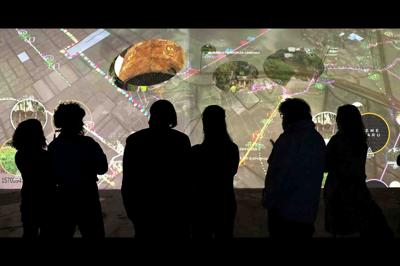Cars define Los Angeles. The spaghetti highways, the luxury cars, the infamous traffic — automotive transport is the default way for people to navigate the sprawling metropolis centered around LA.
Still, even with nearly 6 million registered vehicles in LA County alone, not everyone gets around on four wheels. Millions commute by the bus and train networks every year, especially on the subway Downtown. But Fabian Wagmister, a multimedia digital artist and UCLA professor who founded the first digital media lab at a film school, wants to promote a simpler kind of transport: biking.
“About 10 years ago, I lived Downtown and I started commuting to UCLA by bike. When I started commuting by bike, it really changed my life,” said Wagmister. “It gave me a cognizance of the city. It made me realize I did not know Los Angeles. The Los Angeles you get to know from a car or even public transport is kind of a decontextualized fiction.”
Wagmister’s love of bicycling — which he said changed his relationship with his body and his mental and physical health — inspired him to use his bike as more than just a means to get where he was going. Years ago, he looked to the artistic possibilities of his wheels and gears. That inspired numerous multimedia projects, including exhibitions in Ecuador and Wagmister’s native Argentina.
“I started making the bicycle my main tool for expression,” said Wagmister. “The bike became my brush, and the city became my canvas. Because I’m a digital media artist, I started outfitting my bike with sensors. It was first a personal transformation, then a transformation as an artist.”
Outside of his love of bicycling, Wagmister’s artistic career led him down a multidisciplinary professional path where he brought teams together to combine fine arts (from film and visuals to digital media) with both STEM fields and the social sciences (namely engineering, computer science, sociology and urban planning). Together with partner Jeff Burke, a dean at UCLA’s School of Theater, Film and Television, he directs the Center of Research in Engineering, Media and Performance (REMAP), which uses each of those disciplines to spearhead a diverse array of creative projects, including the recently National Science Foundation-backed initiative for “Civic Bicycle Commuting.”
“All of this — this bicycling life, this passion — led to this idea of a collective bike commuting system that is both a transportation solution for low-income people and a public art creation,” said Wagmister. “(It’ll be) almost like a bikepool. Like carpooling but bikepooling.”
The basic idea for the initiative, also called CiBiC, was to embrace the health and environmental benefits of bike commuting while curbing new cyclists’ safety concerns about riding alone in a city built for cars.
Wagmister and the team of Burke, Anastasia Loukaitou-Sideris (a dean at UCLA’s Luskin School of Public Affairs) and Eli Kaufman (the executive director of the Los Angeles County Bicycle Coalition) got together to work on a landmark digital media initiative that will simultaneously connect commuters, create safe routes around the city, and allow everyone to contribute to a work of public art.
“Promoting creativity in people is one of the most revolutionary ideas you can have. When you awaken creativity in people, they apply it to everything else in their life. There’s this social force when people are creative together,” Wagmister said. “I believe that people who realize they’re creating this collective mural together, it will motivate people to participate. The idea is that these interactive, digital murals will be in Union Station or a community center so that people will see it in real time.”
The project will survey communities and use algorithmic tracking data to plan optimal bike “flows” throughout the city. Once these routes are established, new commuters will be put into groups led by veteran riders who will lead them along the routes. These pods will take commuters to their destinations, sacrificing a little efficiency for the sake of comfort as they go to work.
Once enough data is collected and riders are moving throughout the city, Wagmister plans to create an experimental artwork he calls an “interpretive cartography.” Riders will alter the artwork in real time as they commute, hopefully helping them feel like they’re contributing to an ever-evolving creative project. They can then view the art on the CiBiC app that will be associated with the project or the proposed public installations in places like Union Station.
“The important thing — and that’s where the great challenge is — is it has to be a great piece of art. (Bike commuters) have to say, ‘Wow! We made that,’” said Wagmister on the still-developing artistic output.
As Wagmister and the team work out the design details, they plan to prototype three 10-mile flow corridors by April 2022. They are surveying four Downtown neighborhoods near Union Station: Chinatown, Solano Canyon, Lincoln Heights and the William Mead Housing Project. Eventually, the project will include hundreds of routes across the city, allowing commuters from distant ends of Los Angeles to reach jobs without a drop of gas.
“We do think actually that our project is so timely with the pandemic,” Wagmister said “We think that (CiBiC) gives people a lot of self-efficacy, autonomy. It empowers people. You’re not dependent on your car, on gas. It gives people in communities a sense of resiliency. The most important part in the end is getting people on bicycles as part of their daily life. I know what it’s done to me. It’s a very empowering and enjoyable experience. The bike as a daily facilitator of a better life.”
Ideally, that empowerment will attract commuters who never would have thought to bike to work, even with robust city planning or infrastructure. And with their changes in routine, despite the deeply ingrained car culture in Los Angeles, they could help the city move one step closer to a sustainable future.

